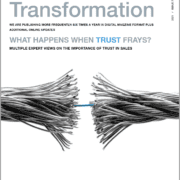CRM Steps for success – Part 1 of 7
According to a recent survey by IBM Global Services, 85% of companies are not feeling fully successful with CRM. The remedies having the greatest impact ‘are not the big ticket items (IT hardware & software) but the human oriented steps’.
Mark Hollyoake of Customer Attuned Ltd outlines 6 steps to transform a technology tool into a fully integrated business process that engages with employees and customers alike.
Drivers |
Needs |
|
|
In our everyday world we are feeling less in control, more stressed and treated like numbers as Fig 1 highlights.
Ironically, most businesses are continually bombarded with pitches for customer management (CM) and customer-relationship management (CRM) systems. The technology is truly impressive but it is not an end itself but rather an enabler for putting the customer genuinely centre-stage in an organisation’s business.
Customer management in its broadest sense is the orientation of an organisation. Is it customer focused-customer centric and how is this manifested within the organisation? How does it find new customers, manage the relationships it has with its current customers and realise value for the organisation?
CM in this context isn’t a pretext for a technology solution, but a management / business philosophy. (Hollyoake 2004)
Bergeron (2002) lays out the need for computer assisted customer databases that drive customer relationship management. He goes onto describe the infrastructural requirements to make Customer Relationship Management happen within the organisation and surrounding processes. Woodcock, et al, (2002) identify a number of concepts and processes (decile analysis, segmentation, life-cycle analysis) that require computer-based data to enable their functionality.
Technology may play a part in a CRM strategy, but technology will not provide the holy grail of customer service excellence Coffey (2001). Bryant (2001) cites Raj Mendes, CRM leader at Cap Gemini Consulting as saying “companies are starting to realise that their CRM projects have placed too much emphasis on technology & ignored customers. They are now trying to put the ‘C’ back into CRM.”
In a similar vein Mahoney (2002) cites Harvard Professor Susan Fournier as saying “CRM programmes have become to much about the technology, not enough about the customer relationship” and that it is time to re-install the ‘R’ into CRM programmes.
So why do things still tend to go wrong with CRM system implementation? Experience suggests that there are three factors that can disrupt and derail CRM implementation:
- Fuzzy accountability: In many cases there is a loss of focus on the customer and the potential to enhance the customer experience. Rather than work with the technology, key staff members circumvent the system using informal networks.
- Resistance to change: Customer-facing staff can kick back against the system. Resistance can stem from a fear of the new or a failure to sell the new system internally. Without a clear CRM vision, staff fail to see the big picture and so when hurdles present themselves during implementation they baulk and become disillusioned. Instead of embracing the whole solution, they start to pick and choose which part they use.
- Resistance to IT: If no one outside the IT department takes ownership for the initiative CRM becomes just one of many IT projects that seem to bear little relevance to the real world of business.
The CRM journey begins with the FIRST step
- CREATING CHAMPIONS
- MAKING THE CASE FOR CHANGE
- PLOTTING THE JOUREY
- MANAGING EXPECTATIONS
- CLARIFYING WHAT’S IN IT FOR STAKHOLDERS
- IDENTIFYING WHAT INDIVIDUALS NEED TO DO
To address these barriers to successful CRM implementation, Customer Attuned has developed a six-step programme for transformation:
| Why Now | The Case for Change |
| We are on a Journey | Becoming a customer centred organisation |
| Setting Expectations | What does this entail? |
| What’s in it for me? | Benefits, reward and value |
| What do I need to do? | Setting our minimum operating standards |
| Surgery | Q&A – Self Help |
This is the human / people face of system implementation
And it’s important to get it right because the IBM research indicates that ‘65 to 75 percent of companies are looking to CRM as important in delivering revenue growth through improved customer experiences, retaining and growing existing customer bases, increasing customer acquisition rates etc…’
In my next article I am going to explore how to create champions in your CRM program.
- Excessive Trust – When Trust Goes Wrong - October 29, 2024
- Identification Based Trust - October 21, 2024
- Introducing Knowledge Based Trust - October 15, 2024



